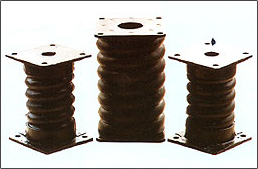Eligo
ELIGO SPRING

- Feature
-
The Eligo spring is composed of a coil spring and rubber on which the coil spring is rolled in the spiral shape. The coil spring receives a part of the Eligo load and at the same time, it prevents the spring from being bent left and being pushed out in the direction of the rubber strength, On the other hand, the rubber receives a part of the load in the form of standing big displacement, and at the same time, it plays a role of damper because of the internal friction,
- Eligo, compared with the metal coil spring, has the following features:
-
- A vulcanized rubber with big internal friction, it is used for coating metal coil springs so it reduces amplification of resonance. In addition, it prevents the sierging effect that is made from the coil spring. Especially, a vulcanized rubber absorbs vibration caused by interaction among molecules and molecular layers so it is suitable for absorbing vibration of high frequency
- The load-displacement relationship makes nonlinear spring features through the elasticity theory of rubber and configural effects so even though the accumulated load changes, the vibration number of the spring system is almost fixed.
- The outside of the coil spring is coated with rubber so it has corrosion -resistance for coil spring and dust-resistance for the devices in it so it can be used for long.
- The coil spring, which is used in cold areas, gets to lose its spring functions in case the spring is fixed by snow, but Eligo is suitable for cold areas without adhesion of springs by snow.
- When using a rubber for eligo, high temperature, oil, creep, and others should be considered for selection of the material
- Usage
-
For anti-dust rubber springs, springs for railroads, bolster type spring, supporting spring for vibrating compressor, supporting spring, anti-dust spring for engine and compressor,
- Specification
-

Records of Specification in Ordering Eligo Spring Classification Special Requirements Remarks Rubber material
in useChoose the material based on the manufacturer's
standards unless specified otherwiseOuter diameter of
Eligo spring (Ro)mm Inner diameter of
Eligo spring (Ri)mm Height of
Eligo spring(Rh)mm Linear diameter of
coil spring (d)mm * The manufacturer can voluntarily change the specifications
for the coil spring, considering the features of the spring.
* The manufacture can randomly choose the material of
the coil spring, considering the features of the springCentral diameter of
coil springmm Free height of coi
spring(Fh)mm Total no. of coil
spring turns (Nt)Vol Thickness of sheet
plate (t)mm Size of
sheet plate(ab)*mm Other special
specificationsRecord of Use
ConditionIndicate use, conditions for use, and environment for use.
Comparison of Domestic Ordinary Rubber Materials Chemical
NameInterna
tional
SymbolOfficial
NameDensity
(g/㎤)Tensile
Strength
(kg/㎟)Elonga
tion
Ratio
(%)Har
dness
(IRHD)Tempera
ture of
Use (℃)Oil
Resis
tancePolyisoprene NK Polyisoprene 0.95 0.51-2.86 1000 30-98 -50 ~ 140 Bad Styrene SBR Polystyrene
rubber0.92 0.51-2.45 700 40-95 -50 ~ 140 Bad Butadiene
copolymerNBR Acrylonitrile
Butadiene
rubber0.98 0.51-2.45 800 40-95 -50 ~ 140 Good Butadiene
copolymerCR Polyisoprene 1.23 0.51-2.75 800 40-95 -50 ~ 140 Very good Isoprene
Isobutylene
rubberIIR Isobutylene -
Isoprene
rubber0.93 0.41-1.73 900 40-90 -50 ~ 150 Bad Polyxylon SI Silicon
rubber1.19 0.20-1.02 500 40-90 -100 ~ 200 Very good Polyurethane - Polyurethane 1.26 2.04-32.62 600 65-95 -30 ~ 80 Good

